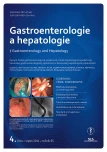What to do when invasive colorectal carcinoma is found in endoscopic resection specimens?
Authors:
P. Vítek 1,2; I. Kajzrlíková 2; J. Chalupa 2; V. Hořava Jr. 3; A. Hájek 4
Authors‘ workplace:
Lékařská fakulta, Ostravská Univerzita, Ostrava2Beskydské gastrocentrum, Interní oddělení, Nemocnice ve Frýdku-Místku, p. o. 3Oddělení patologie, Nemocnice ve Frýdku-Místku, p. o. 4Chirurgicko-traumatologické oddělení, Nemocnice ve Frýdku-Místku, p. o.
1
Published in:
Gastroent Hepatol 2011; 65(4): 202-206
Category:
Endoscopy: Review Article
Overview
When an invasive colorectal carcinoma is found in a resected endoscopic specimen, the endoscopist must evaluate histopathological and endoscopical resection criteria. Personal risk of the patient and surgical risk should also be taken into account. The majority of cases can be treated by endoscopy alone, possibly completed with local ablation techniques and subsequent follow-up. Surgical resection remains an option only for patients with low surgical risk and adverse histopathological and endoscopical lesion characteristics.
Key words:
endoscopy – digestive system – surgery – colorectal carcinoma
Sources
1. Dixon MF. Gastrointestinal epithelial neoplasia: Vienna revisited. Gut 2002; 51(1): 130–131.
2. Ueno H, Mochizuki H, Hashiguchi Y et al. Risk factors for an adverse outcome in early invasive colorectal carcinoma. Gastroenterology 2004; 127(2): 385–394.
3. Yokoyama J, Ajioka Y, Watanabe H et al. Lymph node metastasis and micrometastasis of submucosal invasive colorectal carcinoma: an indicator of the curative potential of endoscopic treatment. Acta Medica Biologica 2002; 50: 1–8.
4. Inoue H, Kashida H, Kudo S et al. The Paris endoscopic classification of superficial neoplastic lesions: esophagus, stomach, and colon: November 30 to December 1, 2002. Gastrointest Endosc 2003; 58 (6 Suppl): S3–43.
5. Cranley JP, Petras RE, Carey WD et al. When is endoscopic polypectomy adequate therapy for colonic polyps containing invasive carcinoma? Gastroenterology 1986; 91(2): 419–427.
6. Sugihara K, Muto T, Morioka Y. Management of patients with invasive carcinoma removed by colonoscopic polypectomy. Dis Colon Rectum 1989; 32(10): 829–834.
7. Ko OB, Byeon JS, Kim MJ et al. The clinical outcome of colonic mucosal cancer with histologically uncertain resection margin after endoscopic resection. Gut 2010; 59 (Suppl III): A418.
8. Prall F. Tumour budding in colorectal carcinoma. Histopathology 2007; 50(1): 151–162.
9. Winawer SJ, O´Brien MJ. Management of malignant polyps. In: Colonoscopy: Principles and Practice 2nd edition Edited by Jerome D Waye Douglas K Rex and Christopher B Williams, Blackwell Publishing Ltd. 2009: 401–411.
10. Lieberman DA, Weiss DG, Bond JH et al. Use of colonoscopy to screen asymptomatic adults for colorectal cancer. Veterans Affairs Cooperative Study Group 380. N Engl J Med 2000; 343(3): 162–168.
11. Winawer SJ, Zauber AG, O‘Brien MJ et al. The National Polyp Study. Design, methods, and characteristics of patients with newly diagnosed polyps. The National Polyp Study Workgroup. Cancer 1992; 70 (5 Suppl): 1236–1245.
12. Urban O, Vítek P, Fojtík P et al. Endoskopická diagnostika a léčba povrchových nepolypózních neoplazií trávicí trubice. Folia Gastroenterol Hepatol 2004; 2(4): 165–173.
13. Urban O, Fojtík P, Kliment M et al. Endoskopická submukózní disekce v léčbě recidivující high-grade neoplazie v rektu. Gastroent Hepatol 2011; 65(2): 80–83.
14. Urban O, Vítek P, Fojtík P et al. Laterally spreading tumors--experience based on 138 consecutive cases. Hepatogastroenterology 2008; 55(82–83): 351–355.
15. Bergmann U, Beger HG. Endoscopic mucosal resection for advanced non-polypoid colorectal adenoma and early stage carcinoma. Surg Endosc 2003; 17(3): 475–479.
16. Urban O, Kliment M, Fojtík P et al. High-frequency ultrasound probe sonography staging for colorectal neoplasia with superficial morphology: its utility and impact on patient management. Surg Endosc 2011; May 18. [Epub ahead of print].
17. Poldermans D, Bax JJ, Boersma E et al. Guidelines for pre-operative cardiac risk assessment and perioperative cardiac management in non-cardiac surgery. Eur Heart J 2009; 30(22): 2769–2812.
18. Wilcox GM, Beck JR. Early invasive cancer in adenomatous colonic polyps („malignant polyps“). Evaluation of the therapeutic options by decision analysis. Gastroenterology 1987; 92 (5 Pt 1): 1159–1168.
19. Longo WE, Virgo KS, Johnson FE et al. Risk factors for morbidity and mortality after colectomy for colon cancer. Dis Colon Rectum 2000; 43(1): 83–91.
20. Hinojosa MW, Konyalian VR, Murrell ZA et al. Outcomes of right and left colectomy at academic centers. Am Surg 2007; 73(10): 945–948.
21. Group COoSTS: A comparison of laparoscopically assisted and open colectomy for colon cancer. N Engl J Med 2004; 350(20): 2050–2059.
22. Faiz O, Haji A, Bottle A et al. Elective colonic surgery for cancer in the elderly: an investigation into postoperative mortality in English NHS hospitals between 1996 and 2007. Colorectal Dis 2010; 13(7): 779–785.
23. Boustiere C, Veitch A, Vanbiervliet G et al. Endoscopy and antiplatelet agents. European Society of Gastrointestinal Endoscopy (ESGE) Guideline. Endoscopy 2011; 43(5): 445–461.
24. Šerclová Z, Dytrych P, Marvan J et al. Fast-track in open intestinal surgery: prospective randomized study (Clinical Trials Gov Identifier no. NCT00123456). Clin Nutr 2009; 28(6): 618–624.
25. Vasen HF, Abdirahman M, Brohet R et al. One to 2-year surveillance intervals reduce risk of colorectal cancer in families with Lynch syndrome. Gastroenterology 2010; 138(7): 2300–2306.
Labels
Paediatric gastroenterology Gastroenterology and hepatology SurgeryArticle was published in
Gastroenterology and Hepatology

2011 Issue 4
Most read in this issue
- Standard of the Czech Society of Gastroenterology for capsule endoscopy of the small intestine
- Autoimmune pancreatitis in a patient with Crohn’s disease
- What to do when invasive colorectal carcinoma is found in endoscopic resection specimens?
- Single-balloon enteroscopy in patients with Crohn’s disease – single centre’s experience
